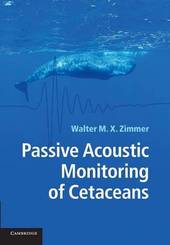
|
Passive Acoustic Monitoring of Cetaceans
Paperback / softback
Main Details
| Title |
Passive Acoustic Monitoring of Cetaceans
|
| Authors and Contributors |
By (author) Walter M. X. Zimmer
|
| Physical Properties |
| Format:Paperback / softback | | Pages:368 | | Dimensions(mm): Height 244,Width 170 |
|
| Category/Genre | Scientific equipment, experiments and techniques
Animal behaviour
Mammals
Marine & freshwater mammals |
|---|
| ISBN/Barcode |
9781107428386
|
| Classifications | Dewey:599.5028 |
|---|
| Audience | | Professional & Vocational | | Tertiary Education (US: College) | |
|---|
|
Publishing Details |
| Publisher |
Cambridge University Press
|
| Imprint |
Cambridge University Press
|
| Publication Date |
7 August 2014 |
| Publication Country |
United Kingdom
|
Description
Passive acoustic monitoring is increasingly used by the scientific community to study, survey and census marine mammals, especially cetaceans, many of which are easier to hear than to see. PAM is also used to support efforts to mitigate potential negative effects of human activities such as ship traffic, military and civilian sonar and offshore exploration. Walter Zimmer provides an integrated approach to PAM, combining physical principles, discussion of technical tools and application-oriented concepts of operations. Additionally, relevant information and tools necessary to assess existing and future PAM systems are presented, with Matlab code used to generate figures and results so readers can reproduce data and modify code to analyse the impact of changes. This allows the principles to be studied whilst discovering potential difficulties and side effects. Aimed at graduate students and researchers, the book provides all information and tools necessary to gain a comprehensive understanding of this interdisciplinary subject.
Author Biography
Walter M. X. Zimmer holds a Ph.D. in Theoretical Physics from the University of Regensburg, Germany. He is currently a Scientist in the Applied Research Department of the NATO Undersea Research Centre (NURC) in La Spezia, Italy and a Guest Investigator at the Biology Department of the Woods Hole Oceanographic Institution (WHOI), Woods Hole, MA, USA.
Reviews'This book is unusual in that it combines underwater acoustics, signal processing and ecology in practical applications of passive acoustic monitoring (PAM) to both marine mammals and anthropogenic noise ... also sets the benchmark for a similar approach to PAM in air ... Two useful practical aspects of the book make PAM more accessible ... First, explicit description and examples of the use of the programme MatLab clarify the processing underlying PAM. Second, detailed discussion of the hardware and software requirements increase the chances of successful deployment ... a must-read ... Anyone with an interest in marine mammals, whether this interest is in acoustics, ecology, behaviour or conservation, will gain an insight into the important role of sound in the life of marine mammals and how sound can give a much-needed, yet unobtrusive, window on the marine world.' Peter McGregor, Cornwall College 'Sound is the medium of choice to sense things in the ocean. Cetaceans evolved acoustic senses to take advantage of ocean sound, but even a decade ago, humans required a ship full of electronics to do so. Now all a student needs is a laptop connected to some hydrophones. Zimmer's book is the first to provide the critical knowledge to enable you to understand the methods required to detect, classify, locate and track marine mammal vocalizations. It is a must have for anyone interested in this growing research area.' Peter L. Tyack, Woods Hole Oceanographic Institution 'I ... believe that one cannot fully understand acoustics without understanding physics, and one cannot understand physics without calculus. So, biologists who want to make important contributions to this exciting new field of research would do well to become proficient in both. Working through this book is probably the best way for a student of PAM to become proficient in the relevant aspects of these fields.' Marine Mammal Science 'This book provides an invaluable, cutting-edge, analytical foundation that will have immediate benefits to those applying passive acoustic tools and analyses in these areas ... this hands-on volume is clearly a major contribution to the field and must be regarded as required reading for those using passive listening methods to study these amazing acoustic animals and mitigate the effects of human activities on wild populations.' Brandon L. Southall, The Quarterly Review of Biology
|